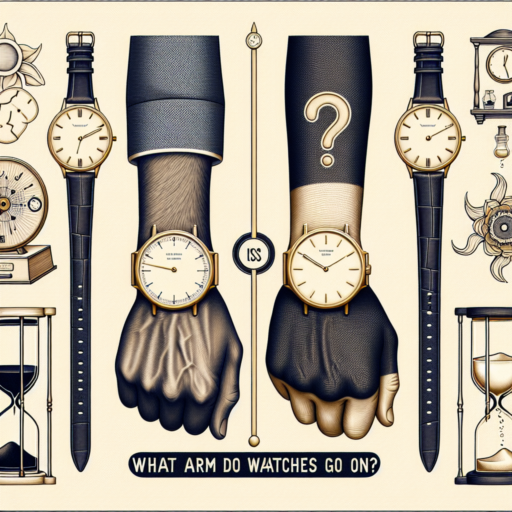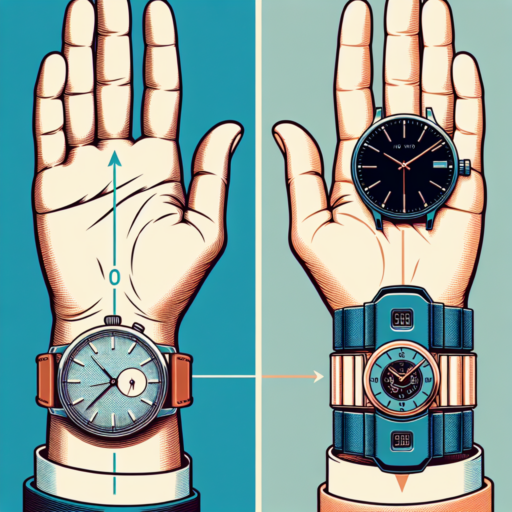No se han encontrado productos.
Introduction: Understanding the Importance of Watch Placement on Wrist
Wearing a watch is a simple act that intertwines with the complexities of personal style, functionality, and comfort. The placement of a watch on the wrist is not merely a matter of slinging it on as an afterthought; it is an art that exemplifies one’s understanding of ergonomics, aesthetics, and tradition. This exploration into the significance of watch placement offers an insight into how this seemingly minute detail can impact both the utility and elegance of wearing a watch.
Historically, the convention has dictated that watches be worn on the wrist opposite to that of the dominant hand. This is not a random stipulation but a practical approach designed to minimize wear and tear on the watch while maximizing ease of access and visibility. A left-handed individual typically wears their watch on the right wrist, and vice versa for a right-handed person. Such placement ensures that the watch does not interfere with the predominant activities of the dominant hand, thus preserving its condition and enhancing comfort.
Beyond the practicalities of wear, the choice of wrist and the position on the wrist speak volumes about personal style and preferences. The distance from the wrist bone, whether the watch sits snugly against it or closer to the base of the hand, alters not just the watch’s appearance but its feel. This choice affects how effortlessly one can glance at the time and impacts the statement the watch makes as part of one’s ensemble. In this context, the deliberate positioning of a watch is an understated yet profound expression of individuality and intentionality in personal styling.
Right Wrist vs. Left Wrist: Which One Should You Choose?
When it comes to deciding between wearing a watch or bracelet on the right wrist versus the left, several factors come into play that can influence your choice. While some may think it’s merely a matter of preference, others believe that functionality, comfort, and even tradition can dictate the most suitable option. This debate often revolves around personal habits, the dominance of one hand, and the type of accessory being worn.
Considerations for Right-Handed Individuals
For the majority who are right-handed, the conventional wisdom suggests wearing watches or bracelets on the non-dominant wrist, which is the left wrist. This practice is rooted in the idea of minimizing wear and tear on accessories from daily tasks and preserving their functionality and aesthetics. The left wrist often undergoes less rigorous movement throughout the day, potentially reducing the risk of damage and scratches. Additionally, wearing accessories on the left wrist can enhance comfort and ease of access to controls for those who use their right hand predominantly.
Left-Handed Users and Accessory Placement
Conversely, left-handed individuals might find it more practical to adorn their right wrist with watches and bracelets. This choice can lead to better protection of their accessories against knocks and damage, given the less active role of the right hand in daily activities. Moreover, for those who prioritize functionality, having their watch on the right wrist facilitates easier access and control, especially with the crown and other adjustment mechanisms typically designed for right-handed operation.
Optimal Position for Your Watch on the Wrist: An In-Depth Guide
Wearing a watch is not just about keeping track of time; it’s also a statement of style and comfort. The optimal position for your watch on the wrist can significantly influence both. Typically, a watch should be worn on the non-dominant wrist, ensuring accessibility and minimizing damage. However, the precise positioning on the wrist plays a crucial role in comfort and visibility.
Factors Influencing Watch Positioning
Several factors come into play when determining the ideal watch position. These include the wrist’s anatomy, watch size and weight, and the type of band. The goal is to find a balance where the watch feels secure without being too tight, allowing the wrist to move freely. A common recommendation is to position the watch just above the wrist bone, enhancing both comfort and ease of movement.
Adjusting for Comfort and Style
Adjustment is key in finding the optimal watch position. A correctly positioned watch not only looks better but also feels better. For those who spend a lot of time typing or writing, positioning the watch slightly higher on the wrist can prevent it from digging into the hand. Similarly, wearing the watch loosely enough that it can move slightly up and down the wrist can accommodate swelling that occurs over the day without compromising on style or functionality.
Does Watch Placement Affect Functionality and Comfort?
When pondering over the details that contribute to the efficacy and satisfaction derived from a wristwatch, the aspect of watch placement emerges as a pivotal consideration. The positioning of a watch on the wrist not only influences its comfort but can also impact its functionality. This intersection of comfort and functionality raises a question of practical importance for watch wearers.
Comfort plays a crucial role in determining how a watch is worn. The watch placement, tightness, and the side of the wrist it’s worn on can significantly affect the wearer’s experience. For instance, a watch worn too tight or too loose can lead to discomfort or even impede blood circulation, thereby affecting the general comfort over time. Moreover, the choice between wearing a watch on the dominant or non-dominant hand significantly influences both the ease of access and the level of comfort experienced by the user.
On the functionality side, precise watch placement ensures optimal performance of the timepiece. For mechanical watches, the position can affect the movement’s accuracy. The influence of gravity on the escapement and gears means that the angle at which a watch is kept during regular wear can impact its timekeeping precision. Similarly, for smartwatches, the placement on the wrist can affect sensor accuracy, such as heart rate monitors and pedometers, thereby influencing the data accuracy and overall functionality of the device.
Style and Etiquette: What Your Watch Placement Says About You
El mundo de los relojes es vasto y lleno de tradiciones, pero una de las decisiones más personales y significativas que puedes tomar como portador de reloj es, sin duda, el brazo en el cual decides llevarlo. La colocación del reloj no solo refleja tu dominio manual sino que también ofrece pistas sobre tu personalidad y estilo de vida.
Tradicionalmente, se ha considerado que llevar el reloj en la muñeca no dominante es la norma. Esto significa que si eres diestro, lo colocarías en tu muñeca izquierda, y viceversa. La razón detrás de esta práctica es puramente funcional; tener el reloj en la muñeca no dominante hace que las tareas diarias sean más fáciles de ejecutar sin interferir con la funcionalidad del reloj. Sin embargo, en el mundo contemporáneo, donde la expresión personal a través del estilo es más valorada, esta norma se ha flexibilizado.
El llevar tu reloj en la muñeca dominante podría ser visto como un signo de rebeldía contra las normas tradicionales, o simplemente como una preferencia personal basada en la comodidad. Para algunos, esta elección puede ser puramente estética, eligiendo destacar su reloj como pieza central de su atuendo. Este sutil gesto puede decir mucho sobre la confianza en uno mismo y la voluntad de desafiar convencionalismos.
How to Secure Your Watch Properly for Different Occasions
Securing your watch correctly is crucial for both its longevity and your comfort, no matter the context. Whether it’s an everyday wear, a luxury piece for special events, or a sports model for active sessions, knowing how to adjust and maintain your watch will ensure it stays secure and functional. This article outlines the best practices for fastening your watch safely and comfortably for any occasion.
Everyday Wear: Finding the Right Fit
For daily use, finding the perfect fit is essential to prevent your watch from sliding around or feeling too tight. Ensure that the watch strap adjusts to your wrist snugly but allows some movement. A rule of thumb is to make sure you can fit your little finger between your wrist and the strap. This balance offers security while providing comfort and allowing your skin to breathe. Regularly inspect your watchband for signs of wear and tear, especially in places prone to high friction.
Special Occasions: Enhancing Security with Style
Special occasions may call for high-end watches that need extra care. For such events, consider a watch with a deployant clasp, which offers a more secure fastening compared to a traditional buckle. Additionally, these clasps provide a sleek look that complements formal wear. Pay attention to the lock mechanism to ensure it’s properly engaged each time you wear your watch. A well-secured timepiece will not only keep it safe but also elevate your attire.
Active Wear: Preparing for Movement
When engaging in sports or any physical activity, securing your watch is vital to prevent damage or loss. Opt for a watch with a sport band made of durable materials like rubber or nylon. These materials offer flexibility and a firm grip on your wrist to withstand vigorous movements. Make sure the band is tight enough to prevent the watch from spinning around your wrist but not so tight as to restrict blood flow. For intense activities, consider a watch with a locking clasp to ensure it remains intact.
Watch Placement Tips for Those with Sensitive Skin
For individuals with sensitive skin, finding a comfortable and non-irritating spot for your watch can be challenging. However, with a few strategic tips, you can wear your favorite timepiece without worrying about skin reactions. The key is understanding the best practices for watch placement and materials that are less likely to cause discomfort.
Choosing the Right Position
Watch placement is crucial for those with sensitive skin. Ideally, you want to position your watch slightly higher on your wrist than you might typically do. This allows your skin to breathe more effectively and reduces the risk of irritation caused by constant rubbing or pressure. Additionally, ensure the fit is neither too tight nor too loose. A watch that’s too tight can cause skin irritation and limit blood flow, while a loose watch can move excessively, leading to increased friction and potential skin damage.
Opt for Skin-Friendly Materials
Another significant aspect to consider is the material of your watch band. For sensitive skin, materials like silicone, fabric, or leather are usually more tolerable than metal bands. It’s beneficial to look for hypoallergenic options that are specifically designed to minimize the risk of skin reactions. Moreover, ensuring the cleanliness of the band by regular washing or wiping can prevent the buildup of irritants that may exacerbate skin sensitivity.
Incorporating these watch placement strategies can make a substantial difference for those with sensitive skin. Finding the ideal position on your wrist and selecting the right material for your watch band can go a long way in ensuring comfort and preventing adverse skin reactions. By addressing these aspects, wearing a watch can become a hassle-free part of your daily routine, even for those with the most sensitive skin.
Adjusting Watch Bands for Perfect Placement: A Step-by-Step Tutorial
Finding the perfect fit for your wrist watch is paramount not just for comfort but also for ensuring the longevity and reliability of your valued timepiece. A well-fitted watch band can transform the experience of wearing your watch, elevating it from a mere accessory to an extension of your personal flair. This step-by-step tutorial is designed to guide you through the process of adjusting watch bands for perfect wrist placement, ensuring both elegance and ease of wear.
Understanding the Types of Watch Bands
Before embarking on the journey of adjusting your watch band, it’s crucial to understand the different types that exist. From the classic leather straps and the versatile stainless steel to the durable silicone and the luxurious gold-plated bands, each type has its unique adjustment method. Knowing whether you’re dealing with a pin-and-tuck, a clasp, or a screw-in link mechanism is the first step towards a well-fitting watch band.
Tools You’ll Need for the Adjustment
Gathering the right tools is essential for adjusting your watch band accurately without causing damage. A small flathead screwdriver, a pin removal tool, or a watch band link remover are indispensable tools depending on the type of band you are adjusting. It’s also wise to work over a soft surface, such as a microfiber cloth, to catch any small parts you may remove and to protect your watch from scratches.
Adjusting a watch band for perfect placement is a detailed process that varies slightly depending on the style and mechanism of your timepiece. Whether adding or removing links from a metal bracelet, adjusting a sliding clasp, or securing a leather strap to the right notch, precision and patience are your allies. Knowing the specifics of your watch band type and having the right tools at hand will lead you to achieve that perfect fit, making your watch feel custom-made for your wrist.
Common Mistakes to Avoid in Watch Placement
Positioning your watch correctly might seem straightforward, but a few common missteps can affect its appearance and functionality. Understanding these errors can significantly enhance your watch-wearing experience. Here, we’ll explore some of the most frequent mishaps to ensure your timepiece not only looks its best but also functions optimally.
Wearing the Watch Too Tight or Too Loose
One of the primary mistakes in watch placement is wearing it too tight or too loose. A watch strapped too tightly can cause discomfort, potentially restrict blood flow, and even damage the watch’s bracelet or strap. On the other hand, wearing it too loosely may lead to excessive movement on the wrist, resulting in wear and tear or even losing the watch. Aim for a snug fit, allowing a finger’s width of space between the watch band and your wrist for optimal comfort and security.
Incorrect Positioning on the Wrist
Another common error is placing the watch either too close to the hand or too high up the arm. Ideally, a watch should be positioned just above the wrist bone, giving it enough room to move and be seen without being obscured by the sleeve. This placement ensures the watch is protected from accidental knocks and offers the wearer more comfort and flexibility. It’s a simple adjustment that makes a significant difference in both the watch’s appearance and its preservation.
Choosing the Wrong Watch for Your Wrist Size
While not directly related to the positioning on the wrist, selecting a timepiece that complements your wrist size is crucial for overall aesthetic and comfort. Oversized watches on slender wrists can appear overwhelming and may slip into incorrect positions more easily, while small watches on large wrists can look out of proportion and also lead to improper placement. Finding a watch that fits the scale of your wrist contributes to a better fit and enhances your overall style.
Conclusion: Mastering the Art of Watch Placement on Your Wrist
Understanding the perfect placement of a watch on your wrist is more than just a matter of personal style; it’s a hallmark of sophistication and knowledge in the world of horology. It’s not simply about wearing a timepiece; it’s about showcasing elegance, comfort, and precision in how the watch complements your wrist and overall attire. The ideal location is crucial for both aesthetics and functionality, ensuring your watch isn’t just an accessory but a statement.
The rule of thumb for the proper placement dictates that a watch should sit just above the wrist bone on the side of your hand. This positioning allows for optimal comfort and ensures that the watch remains visible beneath the cuff of a long-sleeved shirt, making for a seamless look that is both professional and polished. Moreover, the watch should fit snugly; too tight, and it could restrict your movement, too loose, and it may slide to the underside of your wrist, compromising both comfort and elegance.
Adjusting your watch’s fit and placement doesn’t just boil down to these practical considerations; it also includes understanding the nuances of wearing different types of watches. Whether you’re donning a hefty diver’s watch or a slender dress timepiece, the principles of placement ensure that the watch is both seen and felt as an extension of your personal style. Embrace this knowledge, and you will elevate not just your look but your confidence in any setting.




